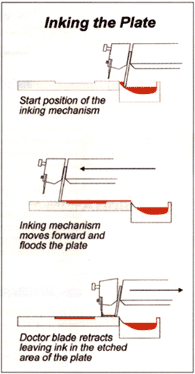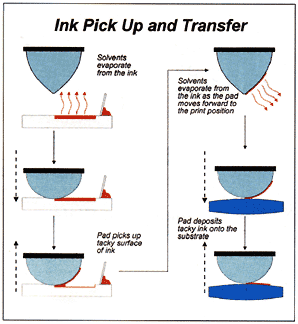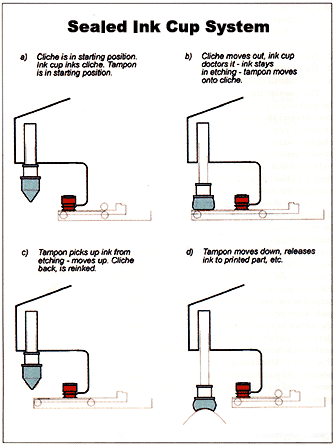WHAT IS PAD PRINTING? WHAT IS SCREEN PRINTING? WHAT IS HOT STAMPING?
What is pad printing ?
Transfer pad printing or tampo printing, commonly known as pad printing, is an "indirect offset gravure" printing process. It was originally used in the watch making industry in Switzerland to decorate watch faces. Pad printing has now developed to a point where it is one of the major methods of printing and decorating the surfaces of objects.
PRINCIPLES
The basic process is very simple. The design to be printed is etched into a flat block, the printing plate. This etching is filled with ink by the inking mechanism. A smooth flexible silicone rubber pad takes up most of the ink from the plate and transfers it to the components.
 INKING THE PLATE INKING THE PLATE
The most common is an open inking mechanism. There are various method. The ink is first spread across the plate and a doctor blade comes down onto the plate, the blade retracts taking the excess ink off the plate and leaving ink in the etched areas. The thinners evaporate from the ink remaining in the etched areas and its surface becomes sticky. The pad comes down onto the plate and the surface rolls across the ink.
INK PICK UP AND TRANSFER
As the pad lifts, the tacky surface of the ink sticks to the pad and lifts out about half of the depth of ink in the etching. This layer of ink is carried towards the print area. During the action, some of the solvent evaporates from the exposed surface of the ink on the pad and this surface becomes tacky. When the pad contacts the components. The film of ink sticks to the surface and separates from the pad as it lifts up. The pad has to be shaped such that when it compresses, the pad surface describes rolling motion. This motion is important as it squeezes out the air over the plate and the ink surface.
THIN FILM PROCESS
The ideal situation is when the maximum amount of ink is picked out of the etching by the pad and all of the ink film is transferred from the pad to the object. Pad printing is a thin film process. Starting with an etch depth of 25 microns 1 micronis 0.001 of a mm) about half of that ink film is picked up. Of this wet ink film 60% is solvent which evaporates leaving only 5microns of dried ink deposit. It is easy to see how susceptible such a thin film can be to changing temperatures, humidity levels, static charges, and variations in airflow. Controlling the rate of evaporation of the solvents from the ink and maintaining the correct solvent balance are the keys to successful pad printing. If the solvents evaporate too quickly the ink might not even pick up from the plate because it has dried in the etched portion of the plate. If the solvents evaporate too slowly, the surface of the ink may not be tacky enough to stick to the pad and lift from the etch. Both conditions, although extremes, will have the same effect - little or no ink ion the pad. Having picked some ink up from the etching onto the pad, if solvents evaporate too quickly, ink dries and stays on the pad. If they evaporate too slowly only some ink will release from the pad onto the substrate. Whichever type of machine that is used there are certain fundamentals that are common. only 5microns of dried ink deposit. It is easy to see how susceptible such a thin film can be to changing temperatures, humidity levels, static charges, and variations in airflow. Controlling the rate of evaporation of the solvents from the ink and maintaining the correct solvent balance are the keys to successful pad printing. If the solvents evaporate too quickly the ink might not even pick up from the plate because it has dried in the etched portion of the plate. If the solvents evaporate too slowly, the surface of the ink may not be tacky enough to stick to the pad and lift from the etch. Both conditions, although extremes, will have the same effect - little or no ink ion the pad. Having picked some ink up from the etching onto the pad, if solvents evaporate too quickly, ink dries and stays on the pad. If they evaporate too slowly only some ink will release from the pad onto the substrate. Whichever type of machine that is used there are certain fundamentals that are common.
THE ETCHED PLATE
There are three main types of etched plate:
1. Thick steel
2. Thin steel
3. Plastic photopolymer
In all cases the image is created photographically. A photopositive is first produced. This must read correctly with the emulsion towards the viewer. Steel plates are coated with a photosensitive coating and the plastic is already photosensitive. The photopositive is then placed on the surface of the plate. The plates with the photosensitive attached are exposed to ultra violet light. This hardens the non-image areas, leaving the image areas to be washed away. In the case of the plastic polymers, either water or a mix of water and alcohol are used. Once washed out, the plate must be dried. This is a simple process. Equipment costs are likely to be in the region of S$3000, the majority of this being the exposure unit and a drying oven. There are custom-made units available that can cost a little more than this. As long as you make sure the plate-making area is clean, there is no reason why high quality plates should not be produced using this type of equipment.
These photopolymer plates will last up to 20,000 cycles, although care is required in setting the machine. Thick steel (5mm - 10mm) etched plates are preferred when runs are likely to be as high as 500,000 upwards. Once the image has been exposed and washed out, the metal itself has to be etched with ferric chloride or hydrochloric acid. Both of these materials are very aggressive and need careful handling, and the thick steel has to be coated with the steel plates. An alternative is to use thin steel plates which can be purchased with the photosensitive coating already applied. These still require the use of an aggressive etching medium but the fact that they are pre-coated with the photosensitive emulsion makes processing a more practical proposition for printers. In terms of quality of print, the plastic photopolymers give the best results, followed by thick steel, and finally thin steel. From the point of view of using the plates in production, the thick steel is by far and away the best followed by thin steel and finally plastic photopolymer. The differences in print quality will only be seen if you are doing highly critical work.
The depth and quality of etch is very important. Normally the depth would be 25 microns. For large areas the depth may increase to 30 microns. It is only in a very specialised applications that it would be any greater than this. The etch depth must be consistent across the plate and there must be no irregularities in the bottom of the etch. The image printed will only be as good as the etch. Some steel plates are made of inferior quality steel with a poor crystalline structure. Flaws in the steel will show as a poor etch and consequently a faulty print.
SILICONE RUBBER TRANSFER PADS
The heart of the pad printing process, as the name suggests, is the printing pad, which is made of silicone rubber. The purpose of this pad is to lift the image out of the etching and place it onto the object. Because the pad is flexible, it enables many different shapes to be printed. It must be able to pick up as much of the ink from the etched portion of the plate as possible and release all that it picks up onto the object without any perceptible distortion. There are 4 factors which affect this process:
1 The shape of the pad
2 The hardness of the pad
3 The condition of the surface of the pad
4 The material that the pad is made from.
The question that is always asked is what should be used to print a particular job. There is no definitive answer, as there are thousands of different shapes of pad. They tend to come into three basic shapes: round, rectangular, and square, and one of these is generally likely to do the job. The shape has to be such that when the pad contacts the plate and then the object to be printed, the surface of the pad rolls over the image. This required rolling action and the size and shape of the image, to a large extent, will determine the pad that you use. Unless the surface to be printed onto is very irregular, then the rule is the harder the pad is the better the ink transfer. There are different types and mixes of silicone rubber; the hardness is often determined by the amount of silicone oil in the mix. With conventional solvent-based inks, the less oil used the better. The ideal printing surface of the pad is very smooth but slightly matt. If pads when new are very shiny it is necessary to dull the surface to achieve a satisfactory print. This can be done by carefully rubbing the pad with a soft tissue soaked in solvent. Care must be taken not to damage this surface. Maintaining surface quality is very important. The pad must be changed if it shows signs of wear. Life of a pad should be in the region of 50,000 prints.
INKS
Pad printing inks are heavily loaded with pigment (17% as against 5% for screen printing) because of the thin film that is required. The solvents used are fast-evaporating and the resin systems often quick drying. A very wide range of inks is available but the usage of them is relatively small, therefore they are generally more expensive than screen printing inks. Specialist inks are produced to stick to the very wide range of substrates printed with the pad printing process. Screen printing inks can be used but they often do not dry fast enough and sometimes have acidic resins which can damage the steel printing plates. The low loading of pigment can also be a problem. I would recommend that you always look for a pad printing ink rather than trying to manage with screen printing inks, although some can be very successful.
PAD PRINTING MACHINES
These machines can be manually operated but they are generally semi-automatic, that is , the operator hand feeds the product to the machine. Fully automatic systems are available and although relatively fast, they can be expensive due to the sophisticated handling systems necessary. The machine you choose is very much dependent upon the production rate required. Hand-operated machines can be acceptable for proofing or short production runs. With a competent operator, you should be able to achieve about 150-200 per hour. Semi-automatic machines will give much more consistent quality and print the same component at 350 per hour. Automatic machines, dependent on the size of component, can print at rates of several thousand per hour. This is achieved by printing multiples. With a conventional system, the actual cycle time of the machine for high-quality printing is unlikely to exceed 1,000 cycles per hour. There are machines that will run up to 5,000 cycles per hour, but the print quality obtained is not always very goods. The open ink trough machine type has already been shown previously in this article. Because it is an open ink trough, the solvents in the ink are evaporating all the time. This means that the printing characteristics will change. If compensation is made for this evaporation by the addition of solvents at regular intervals, the print condition can be stabilised.
CLOSED CUP MACHINE 
The alternative to the open ink trough is the closed cup system. The following drawing shows the operation of this technique. The ink contained in an inverted cup. This cup is kept in contact with the plate by pressure, magnets or even vacuum. The edge of the cup acts as the doctor blade and clears ink from the plate. As the cup is closed, solvents cannot evaporate from the cup itself and the condition of the ink is maintained. The advantage here is that the machine can be used for extended periods without having to adjust the amount of solvent. As control of the ink condition is so important, this system can help stabilise the process. It is not the complete answer. Mixing inks correctly in the first place is essential and ambient conditions can still affect the evaporation of solvent in the etching and on the pad. Machines must be well engineered otherwise considerable plate wear will occur and the cup will scoop ink out of the etching. Check on they cost of replacement cups as they can be very expensive. This system is being used in increasing numbers particularly when mounted into automated production lines.
KEY POINT IN THE PAD PRINTING PROCESS
FILM TO PLATE
In one popular and economical method of pad printing plate making today, the cliche is made by exposing a film positive of the image to be reproduced to a photopolymer coated blank.
PAD TO PLATE
The silicone rubber printing pad is then pressed to the cliche, where it lifts the ink that forms the image to be printed.
PAD TO PRODUCT
The pad is then pressed onto the substrate, which is held in place by a work-holding fixture. The ink is released.
PAD OFF PRODUCT
The pad is lifted from the substrate, and a doctor blade wipes the ink from the surface of the cliche so that the pad will pick up ink from only the areas desired for the next imprint.
What is screen printing ?
ABOUT SCREENPRINTING
From the Latin sericum "silk" and the Greek graphein "to write", screenprinting is a method of printing using a silk screen allowing ink to go through some mesh (mesh which is open) according to the artwork to be printed. Using this process, a large range of materials can be printed : paper, cardboard, cloth, plastic, metal, wood, glass or ceramics.
SCREENPRINTING PRINCIPLE
1) Screen
Screen is made of very thick synthetic or metallic material streched on a rigid frame.
2) Motif
Various methods of blocking the mesh : - in the arts and crafts field, by using glue and other impermeable subtances, a protecting varnish or by the positive stencilling. - in the industrial field, by using stencils where photographic emulsion is cured according to the artwork.
3) Printing
A rubber squeegee spreads a small quantity of ink on the screen. The ink goes through the screen and prints the desired artwork and does not print the blocked areas.
What is hot stamping?
Hot Foil Stamping is a very versatile method of printing. Using foils (available on a roll) it offers instant dry printing without using any messy inks. Hundreds of colors and shades from metallic matte, gloss, pearl and even 22k gold are available.
You have encountered hot stamping in such everyday items as greeting cards, book covers, cosmetic containers, appliances, pens, award ribbons, daily planners and photographs. Hot stamping is a cost effective decorating technique that is easy to set up, clean to operate, and capable of producing products that will last for years while creating a profile center for your business that you may well have overlooked. |

 INKING THE PLATE
INKING THE PLATE  only 5microns of dried ink deposit. It is easy to see how susceptible such a thin film can be to changing temperatures, humidity levels, static charges, and variations in airflow. Controlling the rate of evaporation of the solvents from the ink and maintaining the correct solvent balance are the keys to successful pad printing. If the solvents evaporate too quickly the ink might not even pick up from the plate because it has dried in the etched portion of the plate. If the solvents evaporate too slowly, the surface of the ink may not be tacky enough to stick to the pad and lift from the etch. Both conditions, although extremes, will have the same effect - little or no ink ion the pad. Having picked some ink up from the etching onto the pad, if solvents evaporate too quickly, ink dries and stays on the pad. If they evaporate too slowly only some ink will release from the pad onto the substrate. Whichever type of machine that is used there are certain fundamentals that are common.
only 5microns of dried ink deposit. It is easy to see how susceptible such a thin film can be to changing temperatures, humidity levels, static charges, and variations in airflow. Controlling the rate of evaporation of the solvents from the ink and maintaining the correct solvent balance are the keys to successful pad printing. If the solvents evaporate too quickly the ink might not even pick up from the plate because it has dried in the etched portion of the plate. If the solvents evaporate too slowly, the surface of the ink may not be tacky enough to stick to the pad and lift from the etch. Both conditions, although extremes, will have the same effect - little or no ink ion the pad. Having picked some ink up from the etching onto the pad, if solvents evaporate too quickly, ink dries and stays on the pad. If they evaporate too slowly only some ink will release from the pad onto the substrate. Whichever type of machine that is used there are certain fundamentals that are common. 